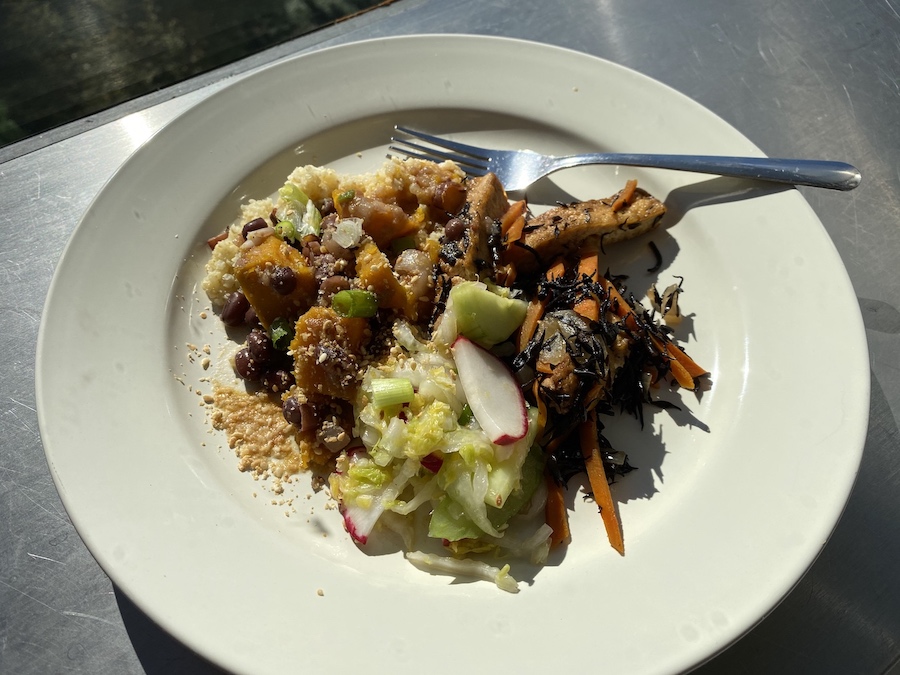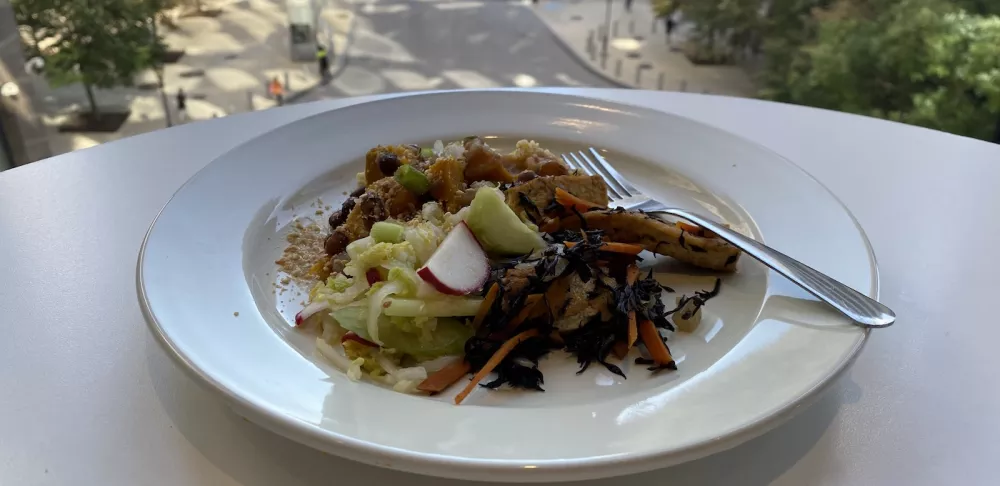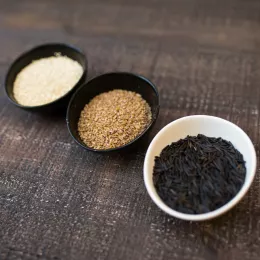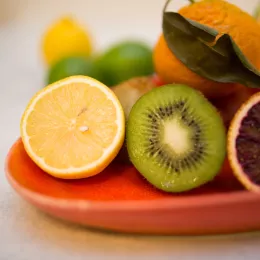Director of Nutrition Celine Beitchman explains why our bodies need protein and how to eat a balanced plant-based diet.
Proteins are macronutrients found in both plants and animals. These complex compounds are made up of small building blocks called amino acids. As protein molecules are too large to be absorbed, our body has to break proteins apart into absorbable units of amino acids.
From absorbing amino acids, our bodies make structural tissue (like bones and organs), enzymes that facilitate chemical reactions, transport compounds (like hemoglobin and lipoprotein) and chemical messengers that keep us functioning (like hormones and antibodies).
Of the 20 amino acids found in nature, nine are essential for human health. Essential nutrients are ones our bodies cannot make; we need to eat them. The nine essential amino acids are histidine, isoleucine, leucine, lysine, methionine, phenylalanine, threonine, tryptophan and valine. If we don’t consume these more or less every day, the body won’t manufacture its own protein-based products efficiently or at all.
High-Quality Proteins
Proteins that provide all nine essential amino acids are called complete or high-quality, and when a protein food lacks one or more essential amino acids, they are incomplete. All animal proteins are complete while only handful plant foods are, including buckwheat, quinoa, soybeans, hemp seeds and chia seeds. If you don’t eat complete protein foods, you can still make up your essential amino acid needs by eating a variety of complementary plant-based proteins within a 24-hour period.
A complementary protein food contains only some essential amino acids. Combined throughout the day, these foods contribute to the body’s essential amino acid pool. In general, beans and legumes are low in the amino acid methionine, while grains, nuts and seeds are low in lysine and threonine. Eating these foods together or throughout the day makes these proteins complete.
Some plant foods provide more protein than others, which is why eating a diet of only vegetables and fruits won’t contribute to long-term health. Beans, nuts, seeds and grains are better sources of protein than vegetables, while fruits are very poor sources altogether. But, eaten throughout the day, all plant foods can contribute to meeting protein recommendations while also contributing to other health benefits.
The chart below shows how plant foods can be combined to make up for limiting factors.
| Eat this food | limited in this amino acid | with this complementary food |
|---|---|---|
| Eat this foodBeans and Legumes | limited in this amino acidMethionine | with this complementary foodGrains, Nuts, Seeds |
| Eat this foodGrains, Nuts, Seeds | limited in this amino acidLysine, Threonine | with this complementary foodBeans and Legumes |
| Eat this foodNuts and Seeds | limited in this amino acidLysine | with this complementary foodBeans and Legumes |
| Eat this foodVegetables | limited in this amino acidMethionine | with this complementary foodGrains, Nuts, Seeds |
| Eat this foodCorn | limited in this amino acidTryptophan, Lysine | with this complementary foodBeans and Legumes |
Can you get too much protein?
In a diverse diet, protein deficiency is rare. There is no added benefit to consuming more protein than you need. Regardless of which dietary pattern is followed, most U.S. adults generally meet or exceed their needs. So, unless you’re a body builder, an endurance athlete or are pregnant or lactating, dietary protein that isn’t put to use — like any excess calorie — is turned into fat.
Which is better — protein from animals or plants?
A body of research suggests diets high in animal proteins increases the risk of cardiovascular disease, kidney disease and some cancers, whereas a plant-rich diet may reduce the risk of dying from non-communicable diseases.
In addition to protein, plants provide fiber, healthy fats, vitamins, minerals, antioxidant phytochemicals and water — and most of us could use more of these in our diet. According to data from the Centers for Disease Control and Prevention, only one in 10 adults eats the recommended serving of vegetables, and even fewer consume beans, legumes, nuts or seeds daily.

But quality distinctions and the final product are important. Not all animal foods are created equal; some options are high in saturated fats or additives like nitrates, sodium and sugar, while others, like grass-fed dairy and wild fish, may be excellent sources of minerals and essential fats — especially important for brain health. Whole plant foods may be contaminated with unwanted pesticides and fungicides, and ultra-processed plant foods stripped of nutrients are poor choices for long-term health.
Interested in plant-based diets but not sure where to start? Try one meatless meal per week or a whole day where plant-foods get full billing. Or enroll in a Health-Supportive Culinary Arts program and practice how to turn a plant-forward approach into a sustainable culinary career.
How much do you need?
The Acceptable Macronutrient Distribution range, developed by the National Institute of Health, recommends protein should make up between 10% to 35% of your total diet. At the gram level, recommendations hover around 0.36 grams per pound of body weight or about 0.8 grams per kilogram of body weight. That’s roughly 46 to 70 grams per day depending on your size. If you are very physically active, pregnant or lactating, you may need to increase your intake by 10%, but only endurance athletes and body builders benefit from more than that.
We can only absorb about 25 to 40 grams of protein at a time, so try not to eat all protein-based meals. Instead, opt for balanced plates that include a variety of whole food protein along with complex carbohydrates and healthy fats.
Proteins are stable and don’t degrade in cooking or long-term storage, which gives us a lot of options for meals and snacks.
These foods all provide roughly seven grams of protein:
- ½ cup beans or legumes
- 1 whole egg
- 1 ounce (handful) nuts or 2 tablespoons nut butter
- 1/3 cup quinoa or buckwheat
- 1 ½ cups vegetables (not including salad greens)
- 1 ounce meat, chicken, fish, or cheese
Choose two to three servings per meal and one or two for snacks and you’ll likely meet minimum daily protein recommendations.
Eating plant-forward is a more sustainable option for the planet.
We can’t talk honestly about food choices without considering its environmental impact. Animal foods are resource-heavy and we would do well to reduce our intake for our health and the health of the planet. According to the Environmental Working Group, if everyone in the U.S. skipped eating meat and cheese one day a week it would be equivalent to taking 7.6 million cars off the road.
In general, when choosing animal foods, opt for leaner cuts, preferably grass-fed or grass-finished, sustainably-farmed or wild. And, when you can, choose plant foods that are minimally-processed, local, organic and seasonal.
Study with Chef Celine in Health-Supportive Culinary Arts.




